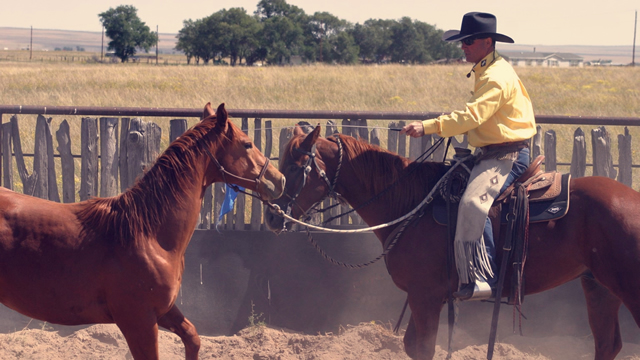Written by Martin Black
This article originally appeared in Eclectic Horseman Issue No.51
When I was a boy, the older buckaroos would say ”Don’t do anything on foot that you can do on horseback.” I learned that if you wanted to become a good horseman that was good advice for two reasons. First by trying to do different jobs using your horse, your horse gets handier. Second, the more you do with your horse, the more you can learn from your horse.
With this background when it came to starting horses, it only made sense to me to do all that could be done from a horse. Again, the horse you are riding has a job, so he has an opportunity to become handier. Not only can you be safer and stronger when need be, but you can also become handier.
In recent articles, we talked about the flagging process, the purpose, the philosophy, and now we can talk about the application from another horse. There are two things to remember and maintain using a horse to flag another horse. First, keep your horse’s head pointed toward the colt’s tail. Second, keep the flag between the colt and your horse as they are in motion. This will be the way to position everything while in motion over ninety percent of the time.
There will be times you may ride straight forward, back-up or side pass, but if the flag is effectively working, the colt will be moving away from you. If your horse is traveling toward the colt’s tail, the rope will be tipping the colt’s nose toward you and the hindquarters away.
Now with those being the primary objectives to positioning, here are some tips that may help. For your horse to travel toward the colt’s tail, your rein hand will be pointed toward the colt’s tail. When you are working from the right side of your horse, you will be on the right side of the colt. Your reins are in the left hand, and flag in your right hand. When you change sides, change hands. If you don’t feel confident and safe with the rope around the saddle horn, hold it in the same hand as your reins. This way as the colt pulls on you, he pulls your rein, turning your horse to catch up. If the colt is pulling too much, raise the flag back over your head away from him to relieve some of the pressure.
As we mentioned earlier, the position of the flag and the angle of the pull on the rope will determine the position of the colt in relation to you. The rope should be adjusted so the colt is at least as far away as your flag can reach. If the colt is responding too much, back off with the flag or give him more rope to give him more distance from you.
If the rope is around the saddle horn, don’t tie off solid. Dally and hold the end with your hand or you can tuck a few inches under your thigh or knee with the end of the rope hanging down in front of your leg. If things become unsafe raise your leg and the rope can be released, the dallies will slip and you can be freed from the colt. Safety is always first.
You should be familiar and confident with dallying or practice beforehand so you are not attempting to do too many new things at once.
As mentioned in previous articles, the flag is positioned generally between the colt’s poll and his loin and between your horse and the colt. This will keep the colt toward the end of the rope and not under your horse’s tail. If the colt is bothered by seeing the flag and you allow him to get to your horse’s tail, with his head down, he will learn to run under the flag and you will have taught him to hide from it. Don’t let this happen. Not only can it be potentially dangerous, it will also make the lesson ineffective.
Working with large animals can be dangerous, especially when they panic and use all their strength. But avoiding trouble can create more trouble. Don’t just postpone dealing with the horse’s fear; it can confirm his fears and make things worse. Pick your battles, deal with them, but pick the time and place that is favorable and safe for you and your horse. Don’t wait and let something happen at an inconvenient and unsafe time.
As discussed in the two previous articles, “Can Your Horse Survive a Fire Drill” (EH #49) and “Thoughts on Using a Flag” (EH #50), this process will help not only young horses that haven’t been handled much but older horses that don’t handle a crisis very well. If a horse is braced in the poll and loin, he can learn to soften up. A horse can learn a safe way to respond to frightful situations. He can learn to stop and accept pressure, so he can stand for saddling, picking up his feet, brushing or anything else that may have been bothering him, and causing him to move. Parking your horse is teaching control and is just as important as having control to go right or left, forward or backwards. As a horse learns all this, desensitizing becomes the by-product. A desensitized horse that you cannot control the feet on is, to me, still a dangerous horse.
Obvious things like getting off your horse to open a gate could be made easier after taking some time to learn to do it from your horse. While working cattle in a corral, we can learn to understand cattle and how to work from a horse and make the job better for the cattle by being less stressful, and again you and your horse can become handier.
This article originally appeared in Eclectic Horseman Issue No.51
https://eclectic-horseman.com/mercantile/horse-training-dvds/fundamental-horse-training/colt-starting-philosophy-with-martin-black/


